Balance Scorecard: Features, Differences from Traditional Performance Measurement, and Suitability for Tesco Plc
VerifiedAdded on 2023/06/13
|15
|3354
|171
AI Summary
This article discusses the features of the balance scorecard, how it differs from traditional performance measurement, and its suitability for Tesco Plc. It also includes a brief discussion on Tesco Plc and its activities.
Contribute Materials
Your contribution can guide someone’s learning journey. Share your
documents today.
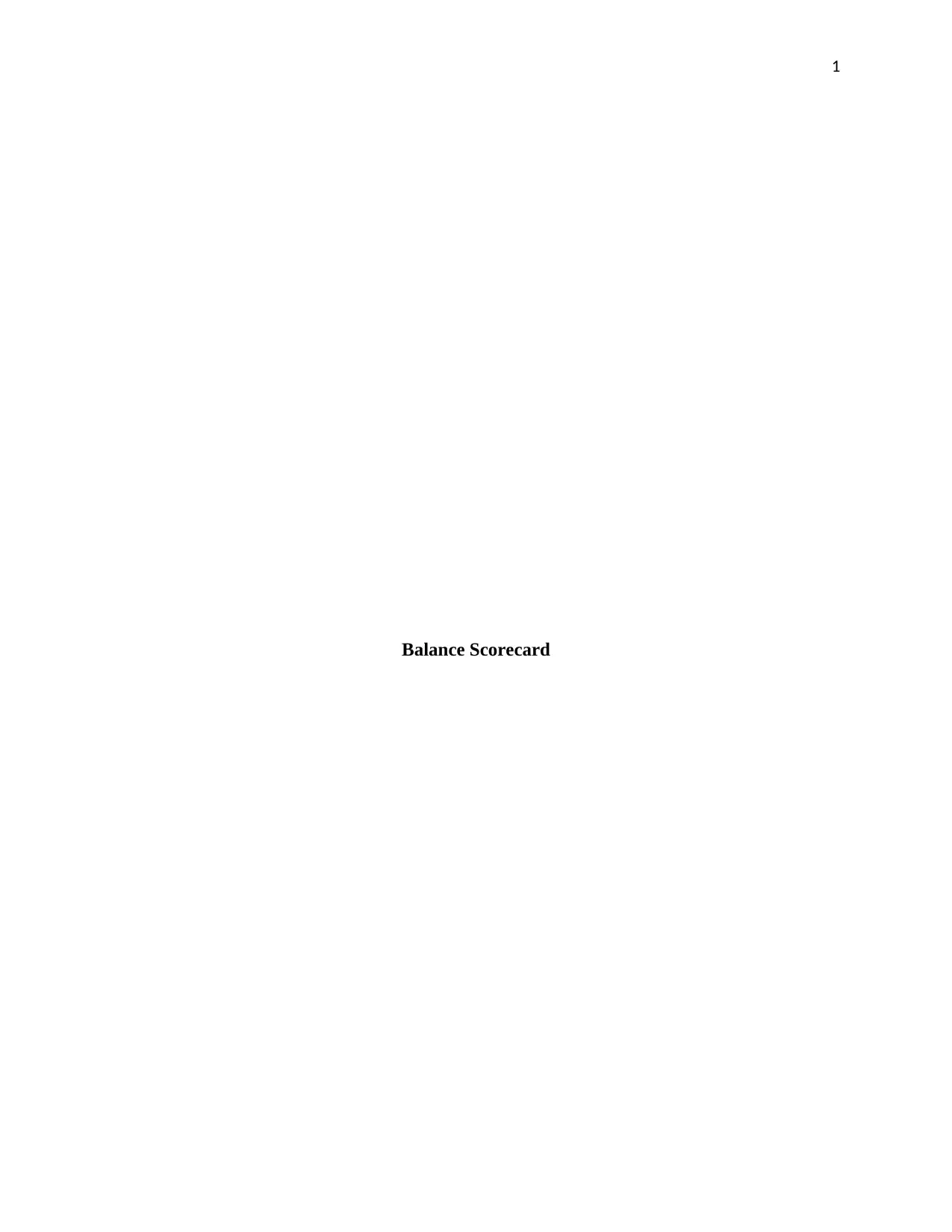
1
Balance Scorecard
Balance Scorecard
Secure Best Marks with AI Grader
Need help grading? Try our AI Grader for instant feedback on your assignments.
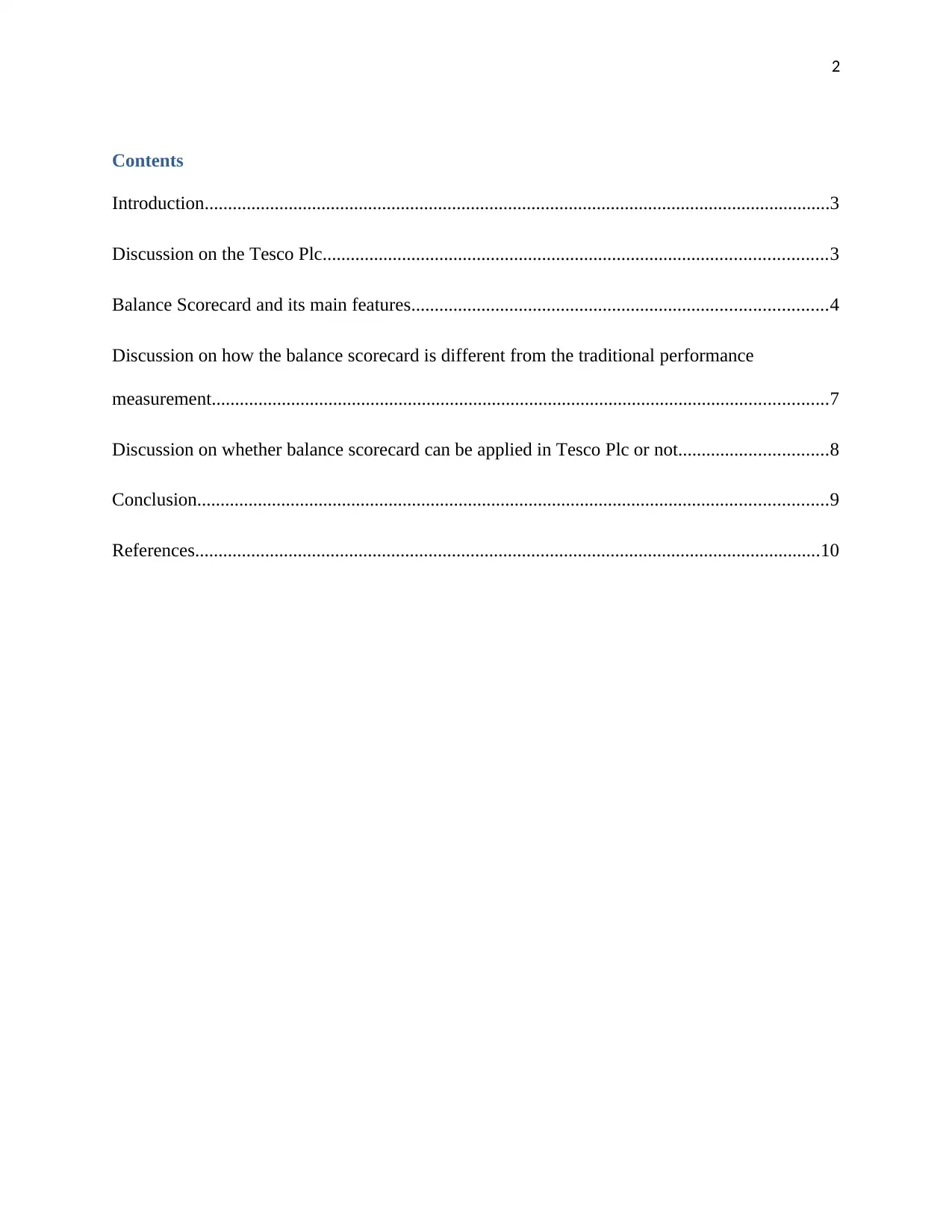
2
Contents
Introduction......................................................................................................................................3
Discussion on the Tesco Plc............................................................................................................3
Balance Scorecard and its main features.........................................................................................4
Discussion on how the balance scorecard is different from the traditional performance
measurement....................................................................................................................................7
Discussion on whether balance scorecard can be applied in Tesco Plc or not................................8
Conclusion.......................................................................................................................................9
References......................................................................................................................................10
Contents
Introduction......................................................................................................................................3
Discussion on the Tesco Plc............................................................................................................3
Balance Scorecard and its main features.........................................................................................4
Discussion on how the balance scorecard is different from the traditional performance
measurement....................................................................................................................................7
Discussion on whether balance scorecard can be applied in Tesco Plc or not................................8
Conclusion.......................................................................................................................................9
References......................................................................................................................................10
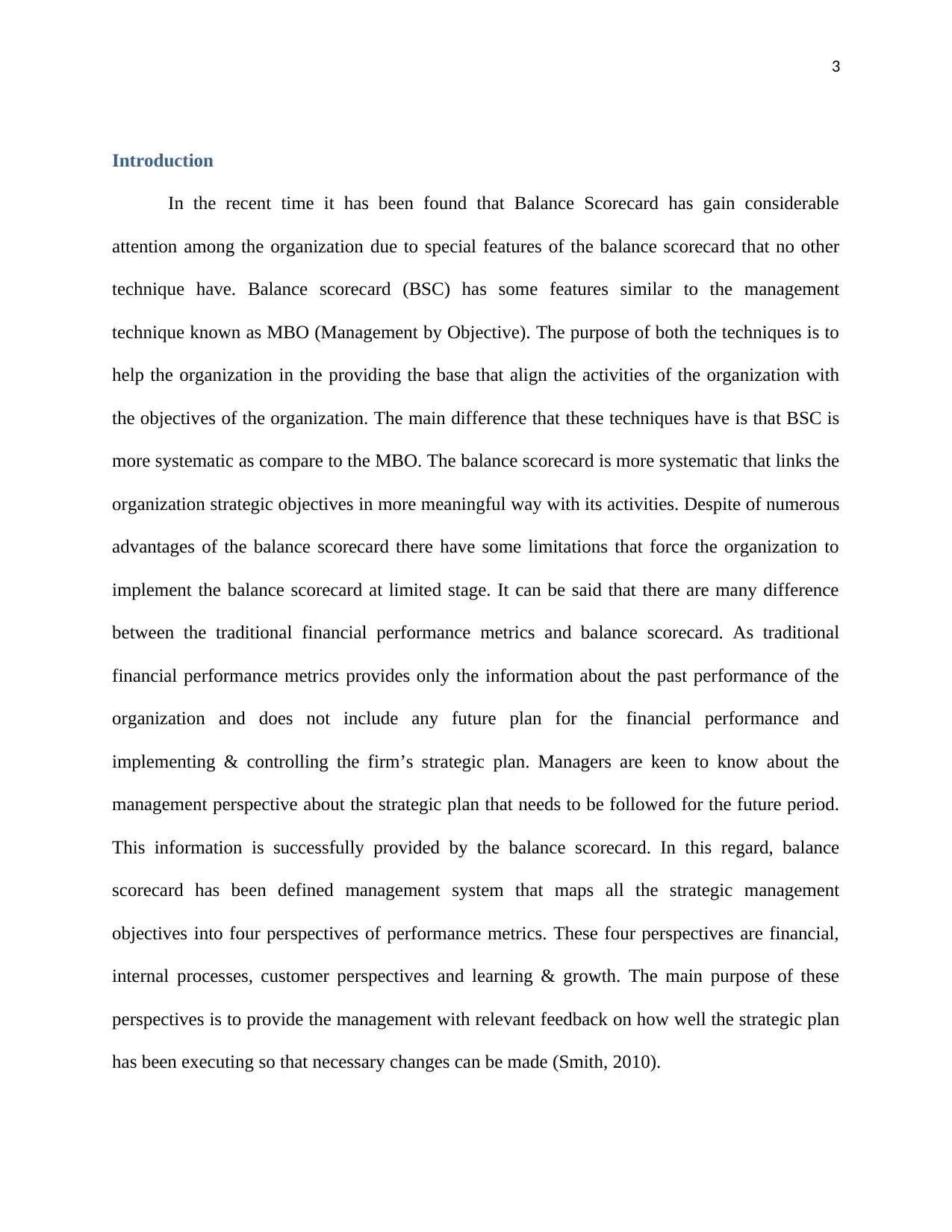
3
Introduction
In the recent time it has been found that Balance Scorecard has gain considerable
attention among the organization due to special features of the balance scorecard that no other
technique have. Balance scorecard (BSC) has some features similar to the management
technique known as MBO (Management by Objective). The purpose of both the techniques is to
help the organization in the providing the base that align the activities of the organization with
the objectives of the organization. The main difference that these techniques have is that BSC is
more systematic as compare to the MBO. The balance scorecard is more systematic that links the
organization strategic objectives in more meaningful way with its activities. Despite of numerous
advantages of the balance scorecard there have some limitations that force the organization to
implement the balance scorecard at limited stage. It can be said that there are many difference
between the traditional financial performance metrics and balance scorecard. As traditional
financial performance metrics provides only the information about the past performance of the
organization and does not include any future plan for the financial performance and
implementing & controlling the firm’s strategic plan. Managers are keen to know about the
management perspective about the strategic plan that needs to be followed for the future period.
This information is successfully provided by the balance scorecard. In this regard, balance
scorecard has been defined management system that maps all the strategic management
objectives into four perspectives of performance metrics. These four perspectives are financial,
internal processes, customer perspectives and learning & growth. The main purpose of these
perspectives is to provide the management with relevant feedback on how well the strategic plan
has been executing so that necessary changes can be made (Smith, 2010).
Introduction
In the recent time it has been found that Balance Scorecard has gain considerable
attention among the organization due to special features of the balance scorecard that no other
technique have. Balance scorecard (BSC) has some features similar to the management
technique known as MBO (Management by Objective). The purpose of both the techniques is to
help the organization in the providing the base that align the activities of the organization with
the objectives of the organization. The main difference that these techniques have is that BSC is
more systematic as compare to the MBO. The balance scorecard is more systematic that links the
organization strategic objectives in more meaningful way with its activities. Despite of numerous
advantages of the balance scorecard there have some limitations that force the organization to
implement the balance scorecard at limited stage. It can be said that there are many difference
between the traditional financial performance metrics and balance scorecard. As traditional
financial performance metrics provides only the information about the past performance of the
organization and does not include any future plan for the financial performance and
implementing & controlling the firm’s strategic plan. Managers are keen to know about the
management perspective about the strategic plan that needs to be followed for the future period.
This information is successfully provided by the balance scorecard. In this regard, balance
scorecard has been defined management system that maps all the strategic management
objectives into four perspectives of performance metrics. These four perspectives are financial,
internal processes, customer perspectives and learning & growth. The main purpose of these
perspectives is to provide the management with relevant feedback on how well the strategic plan
has been executing so that necessary changes can be made (Smith, 2010).
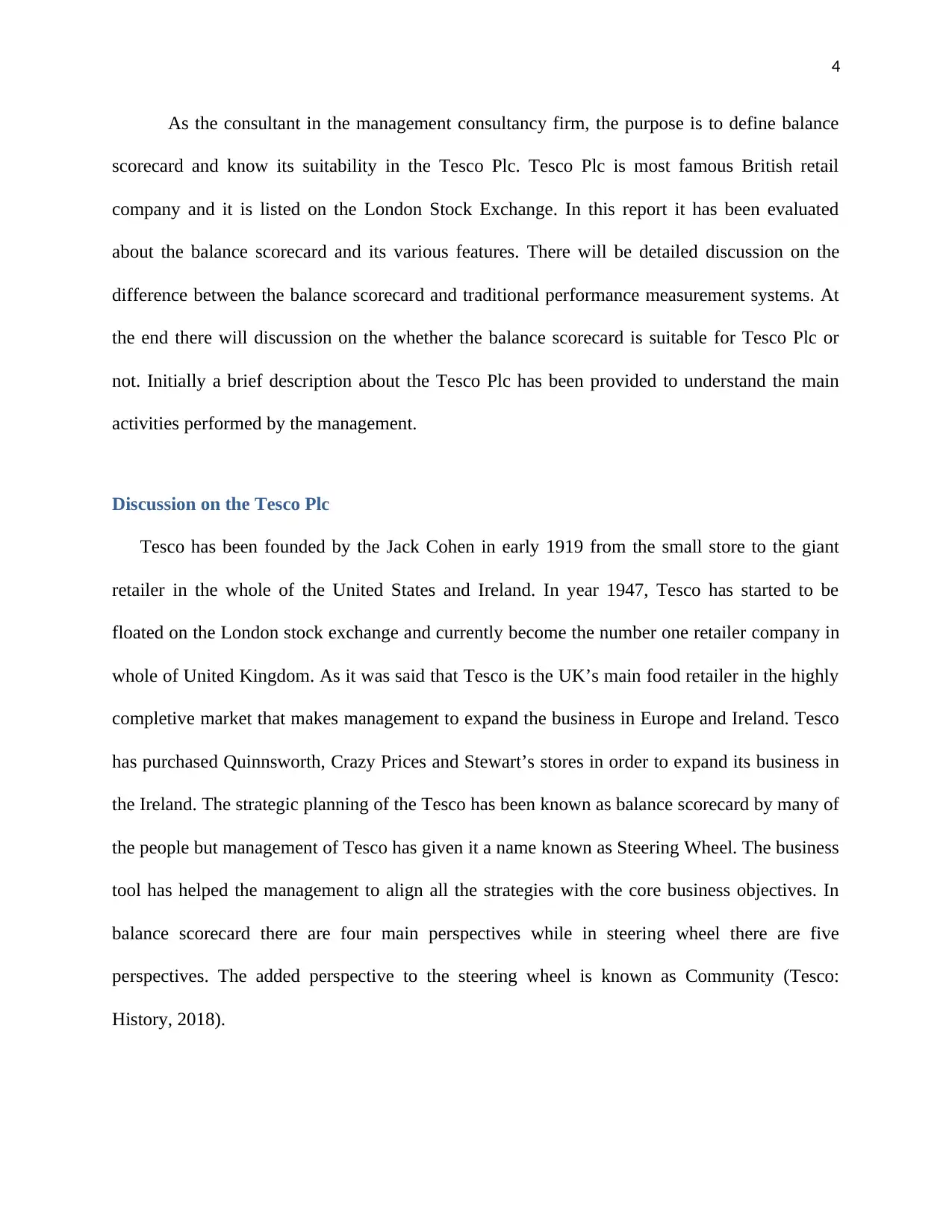
4
As the consultant in the management consultancy firm, the purpose is to define balance
scorecard and know its suitability in the Tesco Plc. Tesco Plc is most famous British retail
company and it is listed on the London Stock Exchange. In this report it has been evaluated
about the balance scorecard and its various features. There will be detailed discussion on the
difference between the balance scorecard and traditional performance measurement systems. At
the end there will discussion on the whether the balance scorecard is suitable for Tesco Plc or
not. Initially a brief description about the Tesco Plc has been provided to understand the main
activities performed by the management.
Discussion on the Tesco Plc
Tesco has been founded by the Jack Cohen in early 1919 from the small store to the giant
retailer in the whole of the United States and Ireland. In year 1947, Tesco has started to be
floated on the London stock exchange and currently become the number one retailer company in
whole of United Kingdom. As it was said that Tesco is the UK’s main food retailer in the highly
completive market that makes management to expand the business in Europe and Ireland. Tesco
has purchased Quinnsworth, Crazy Prices and Stewart’s stores in order to expand its business in
the Ireland. The strategic planning of the Tesco has been known as balance scorecard by many of
the people but management of Tesco has given it a name known as Steering Wheel. The business
tool has helped the management to align all the strategies with the core business objectives. In
balance scorecard there are four main perspectives while in steering wheel there are five
perspectives. The added perspective to the steering wheel is known as Community (Tesco:
History, 2018).
As the consultant in the management consultancy firm, the purpose is to define balance
scorecard and know its suitability in the Tesco Plc. Tesco Plc is most famous British retail
company and it is listed on the London Stock Exchange. In this report it has been evaluated
about the balance scorecard and its various features. There will be detailed discussion on the
difference between the balance scorecard and traditional performance measurement systems. At
the end there will discussion on the whether the balance scorecard is suitable for Tesco Plc or
not. Initially a brief description about the Tesco Plc has been provided to understand the main
activities performed by the management.
Discussion on the Tesco Plc
Tesco has been founded by the Jack Cohen in early 1919 from the small store to the giant
retailer in the whole of the United States and Ireland. In year 1947, Tesco has started to be
floated on the London stock exchange and currently become the number one retailer company in
whole of United Kingdom. As it was said that Tesco is the UK’s main food retailer in the highly
completive market that makes management to expand the business in Europe and Ireland. Tesco
has purchased Quinnsworth, Crazy Prices and Stewart’s stores in order to expand its business in
the Ireland. The strategic planning of the Tesco has been known as balance scorecard by many of
the people but management of Tesco has given it a name known as Steering Wheel. The business
tool has helped the management to align all the strategies with the core business objectives. In
balance scorecard there are four main perspectives while in steering wheel there are five
perspectives. The added perspective to the steering wheel is known as Community (Tesco:
History, 2018).
Secure Best Marks with AI Grader
Need help grading? Try our AI Grader for instant feedback on your assignments.
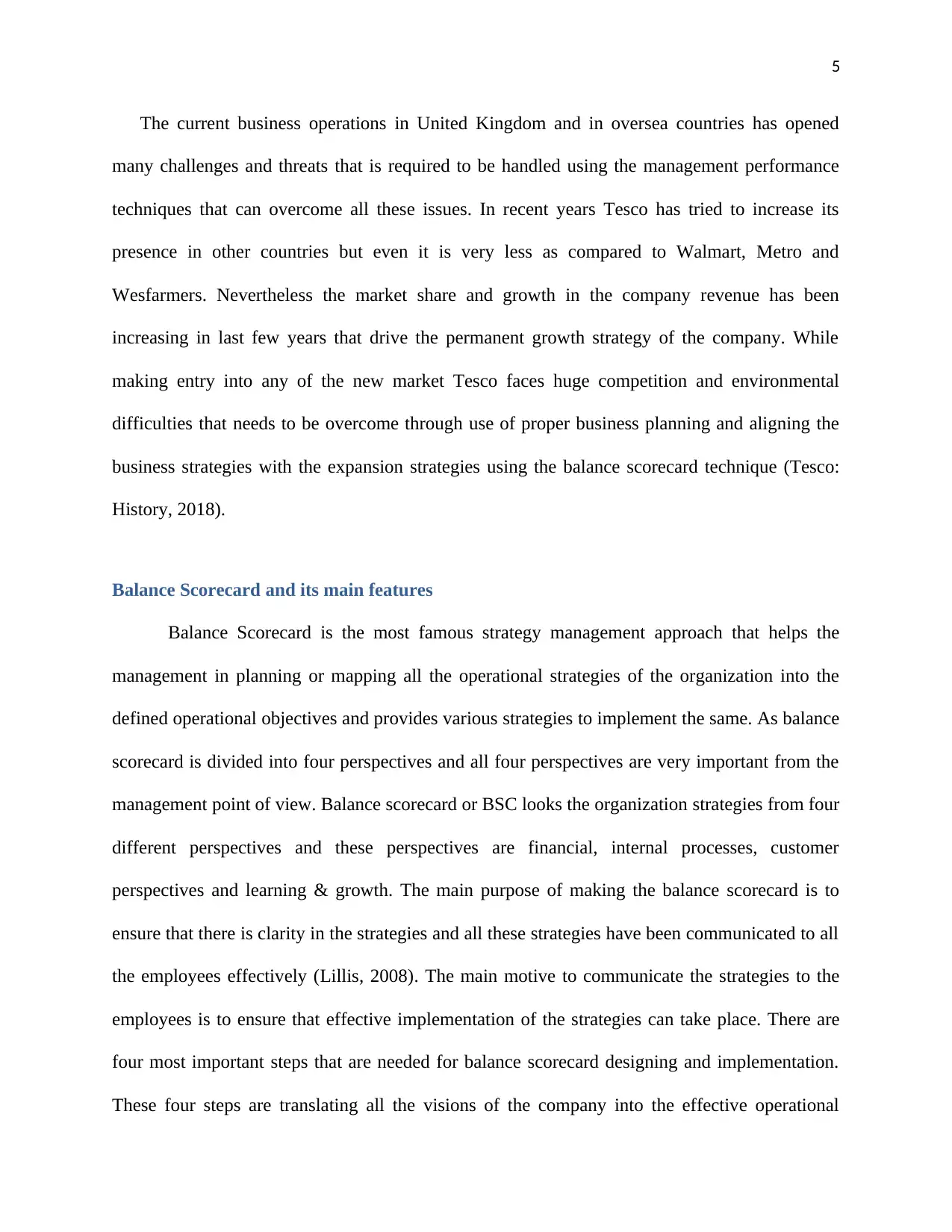
5
The current business operations in United Kingdom and in oversea countries has opened
many challenges and threats that is required to be handled using the management performance
techniques that can overcome all these issues. In recent years Tesco has tried to increase its
presence in other countries but even it is very less as compared to Walmart, Metro and
Wesfarmers. Nevertheless the market share and growth in the company revenue has been
increasing in last few years that drive the permanent growth strategy of the company. While
making entry into any of the new market Tesco faces huge competition and environmental
difficulties that needs to be overcome through use of proper business planning and aligning the
business strategies with the expansion strategies using the balance scorecard technique (Tesco:
History, 2018).
Balance Scorecard and its main features
Balance Scorecard is the most famous strategy management approach that helps the
management in planning or mapping all the operational strategies of the organization into the
defined operational objectives and provides various strategies to implement the same. As balance
scorecard is divided into four perspectives and all four perspectives are very important from the
management point of view. Balance scorecard or BSC looks the organization strategies from four
different perspectives and these perspectives are financial, internal processes, customer
perspectives and learning & growth. The main purpose of making the balance scorecard is to
ensure that there is clarity in the strategies and all these strategies have been communicated to all
the employees effectively (Lillis, 2008). The main motive to communicate the strategies to the
employees is to ensure that effective implementation of the strategies can take place. There are
four most important steps that are needed for balance scorecard designing and implementation.
These four steps are translating all the visions of the company into the effective operational
The current business operations in United Kingdom and in oversea countries has opened
many challenges and threats that is required to be handled using the management performance
techniques that can overcome all these issues. In recent years Tesco has tried to increase its
presence in other countries but even it is very less as compared to Walmart, Metro and
Wesfarmers. Nevertheless the market share and growth in the company revenue has been
increasing in last few years that drive the permanent growth strategy of the company. While
making entry into any of the new market Tesco faces huge competition and environmental
difficulties that needs to be overcome through use of proper business planning and aligning the
business strategies with the expansion strategies using the balance scorecard technique (Tesco:
History, 2018).
Balance Scorecard and its main features
Balance Scorecard is the most famous strategy management approach that helps the
management in planning or mapping all the operational strategies of the organization into the
defined operational objectives and provides various strategies to implement the same. As balance
scorecard is divided into four perspectives and all four perspectives are very important from the
management point of view. Balance scorecard or BSC looks the organization strategies from four
different perspectives and these perspectives are financial, internal processes, customer
perspectives and learning & growth. The main purpose of making the balance scorecard is to
ensure that there is clarity in the strategies and all these strategies have been communicated to all
the employees effectively (Lillis, 2008). The main motive to communicate the strategies to the
employees is to ensure that effective implementation of the strategies can take place. There are
four most important steps that are needed for balance scorecard designing and implementation.
These four steps are translating all the visions of the company into the effective operational

6
objectives, circulating the visions and goals in the organization and linking them with the
performance of individuals, changes that are made in the already designed strategies according to
the feedback received and lastly learning that is required on the base of the total outcome of the
implemented strategies. In short it can be said that balance scorecard takes past year financial
performance to link them with the drivers of the future performance. The objectives and
measures that are needed to frame the BSC are derived from the vision and strategies of an
organization. Through use of balance scorecard management executives can measure how the
business units create the value for their current and future customers. BSC helps in enhancing the
internal business capabilities and also improve the business all around performance through
incorporating the people, system and procedures necessary for the organization (Eisenberg,
2016).
Balance scorecard helps in maintaining the balance between the long term and short term
objectives of the company. It also helps in maintaining the proper balance between the financial
outcomes and business performance drivers through following the continuous process of learning
and adoption of the modified strategies. According to the balance scorecard every business
strategies need to be broken into the various operational strategic objectives through taking into
consideration the value proposition of the customers.
The framework of balance scorecard has been provided below:
objectives, circulating the visions and goals in the organization and linking them with the
performance of individuals, changes that are made in the already designed strategies according to
the feedback received and lastly learning that is required on the base of the total outcome of the
implemented strategies. In short it can be said that balance scorecard takes past year financial
performance to link them with the drivers of the future performance. The objectives and
measures that are needed to frame the BSC are derived from the vision and strategies of an
organization. Through use of balance scorecard management executives can measure how the
business units create the value for their current and future customers. BSC helps in enhancing the
internal business capabilities and also improve the business all around performance through
incorporating the people, system and procedures necessary for the organization (Eisenberg,
2016).
Balance scorecard helps in maintaining the balance between the long term and short term
objectives of the company. It also helps in maintaining the proper balance between the financial
outcomes and business performance drivers through following the continuous process of learning
and adoption of the modified strategies. According to the balance scorecard every business
strategies need to be broken into the various operational strategic objectives through taking into
consideration the value proposition of the customers.
The framework of balance scorecard has been provided below:
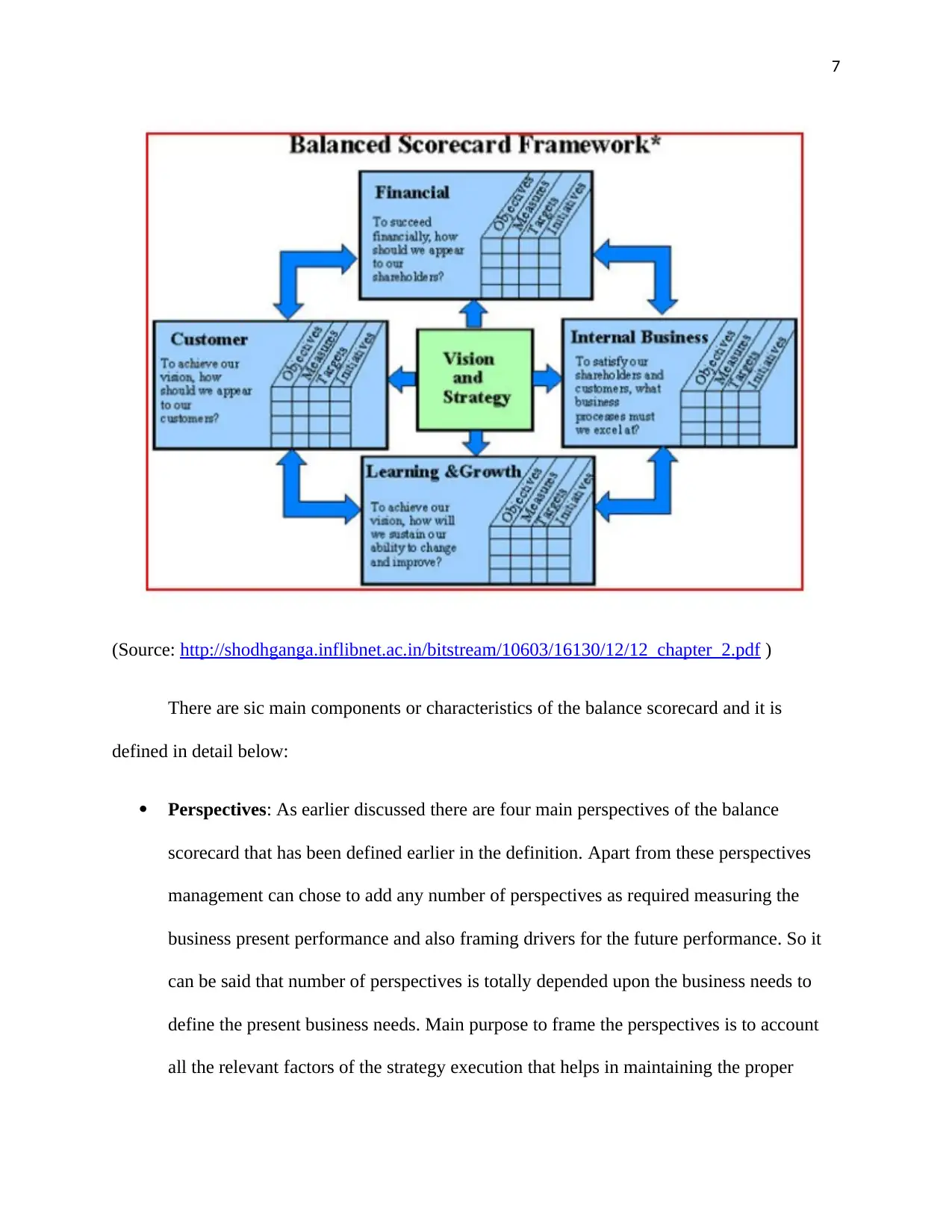
7
(Source: http://shodhganga.inflibnet.ac.in/bitstream/10603/16130/12/12_chapter_2.pdf )
There are sic main components or characteristics of the balance scorecard and it is
defined in detail below:
Perspectives: As earlier discussed there are four main perspectives of the balance
scorecard that has been defined earlier in the definition. Apart from these perspectives
management can chose to add any number of perspectives as required measuring the
business present performance and also framing drivers for the future performance. So it
can be said that number of perspectives is totally depended upon the business needs to
define the present business needs. Main purpose to frame the perspectives is to account
all the relevant factors of the strategy execution that helps in maintaining the proper
(Source: http://shodhganga.inflibnet.ac.in/bitstream/10603/16130/12/12_chapter_2.pdf )
There are sic main components or characteristics of the balance scorecard and it is
defined in detail below:
Perspectives: As earlier discussed there are four main perspectives of the balance
scorecard that has been defined earlier in the definition. Apart from these perspectives
management can chose to add any number of perspectives as required measuring the
business present performance and also framing drivers for the future performance. So it
can be said that number of perspectives is totally depended upon the business needs to
define the present business needs. Main purpose to frame the perspectives is to account
all the relevant factors of the strategy execution that helps in maintaining the proper
Paraphrase This Document
Need a fresh take? Get an instant paraphrase of this document with our AI Paraphraser

8
balance between the short term and long term objectives of the company. So it can be
said that perspectives are basic architecture that is needed to frame the balance scorecard.
Themes: Themes are provided in the business strategies and it provides detailed view on
how the business carries out its mission.
Business objectives: They represent the critical factors that are essential for the success
of the organization and it must be certainly achieved to fulfill the goals and vision.
Measures: It is certain that what can be measured is also achievable. So it can be said
that organization determines success in executing the business strategies. Measures help
in achieving the two basic fundamentals of business organization. They are
organizational motivation and objective evaluation.
Targets: Targets are needed to evaluate the performance of the individuals and define the
level of performance that is certainly needed to achieve the business targets.
Initiatives: They refer to the key action plan that is needed to be executed by the
management so that business objectives can be met easily (Bardy, 2011).
All the above characteristics of the balance scorecard help to know that there is proper
balance between the financial and non financial measures that is essential for achieving the
business objectives effectively.
The key features that are required to frame the good balance scorecard:
Financial Evaluation: Financial analysis is the most important or traditional feature of
the balance scorecard. It is certain that no management will preferred such business tool
that does not considered the financial perspectives as the most important measure. The
financial analysis is very important because it provides discussion on the business profits
balance between the short term and long term objectives of the company. So it can be
said that perspectives are basic architecture that is needed to frame the balance scorecard.
Themes: Themes are provided in the business strategies and it provides detailed view on
how the business carries out its mission.
Business objectives: They represent the critical factors that are essential for the success
of the organization and it must be certainly achieved to fulfill the goals and vision.
Measures: It is certain that what can be measured is also achievable. So it can be said
that organization determines success in executing the business strategies. Measures help
in achieving the two basic fundamentals of business organization. They are
organizational motivation and objective evaluation.
Targets: Targets are needed to evaluate the performance of the individuals and define the
level of performance that is certainly needed to achieve the business targets.
Initiatives: They refer to the key action plan that is needed to be executed by the
management so that business objectives can be met easily (Bardy, 2011).
All the above characteristics of the balance scorecard help to know that there is proper
balance between the financial and non financial measures that is essential for achieving the
business objectives effectively.
The key features that are required to frame the good balance scorecard:
Financial Evaluation: Financial analysis is the most important or traditional feature of
the balance scorecard. It is certain that no management will preferred such business tool
that does not considered the financial perspectives as the most important measure. The
financial analysis is very important because it provides discussion on the business profits
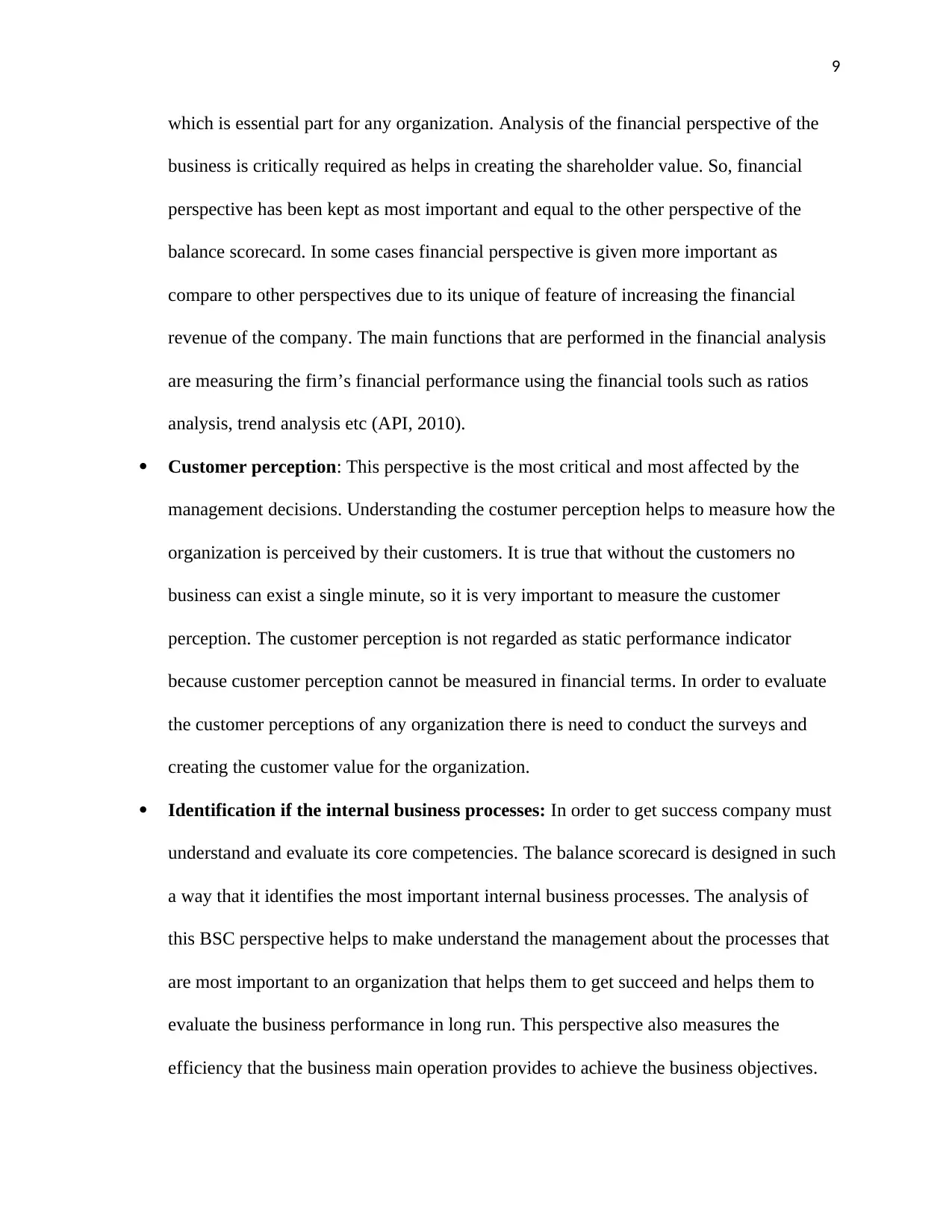
9
which is essential part for any organization. Analysis of the financial perspective of the
business is critically required as helps in creating the shareholder value. So, financial
perspective has been kept as most important and equal to the other perspective of the
balance scorecard. In some cases financial perspective is given more important as
compare to other perspectives due to its unique of feature of increasing the financial
revenue of the company. The main functions that are performed in the financial analysis
are measuring the firm’s financial performance using the financial tools such as ratios
analysis, trend analysis etc (API, 2010).
Customer perception: This perspective is the most critical and most affected by the
management decisions. Understanding the costumer perception helps to measure how the
organization is perceived by their customers. It is true that without the customers no
business can exist a single minute, so it is very important to measure the customer
perception. The customer perception is not regarded as static performance indicator
because customer perception cannot be measured in financial terms. In order to evaluate
the customer perceptions of any organization there is need to conduct the surveys and
creating the customer value for the organization.
Identification if the internal business processes: In order to get success company must
understand and evaluate its core competencies. The balance scorecard is designed in such
a way that it identifies the most important internal business processes. The analysis of
this BSC perspective helps to make understand the management about the processes that
are most important to an organization that helps them to get succeed and helps them to
evaluate the business performance in long run. This perspective also measures the
efficiency that the business main operation provides to achieve the business objectives.
which is essential part for any organization. Analysis of the financial perspective of the
business is critically required as helps in creating the shareholder value. So, financial
perspective has been kept as most important and equal to the other perspective of the
balance scorecard. In some cases financial perspective is given more important as
compare to other perspectives due to its unique of feature of increasing the financial
revenue of the company. The main functions that are performed in the financial analysis
are measuring the firm’s financial performance using the financial tools such as ratios
analysis, trend analysis etc (API, 2010).
Customer perception: This perspective is the most critical and most affected by the
management decisions. Understanding the costumer perception helps to measure how the
organization is perceived by their customers. It is true that without the customers no
business can exist a single minute, so it is very important to measure the customer
perception. The customer perception is not regarded as static performance indicator
because customer perception cannot be measured in financial terms. In order to evaluate
the customer perceptions of any organization there is need to conduct the surveys and
creating the customer value for the organization.
Identification if the internal business processes: In order to get success company must
understand and evaluate its core competencies. The balance scorecard is designed in such
a way that it identifies the most important internal business processes. The analysis of
this BSC perspective helps to make understand the management about the processes that
are most important to an organization that helps them to get succeed and helps them to
evaluate the business performance in long run. This perspective also measures the
efficiency that the business main operation provides to achieve the business objectives.
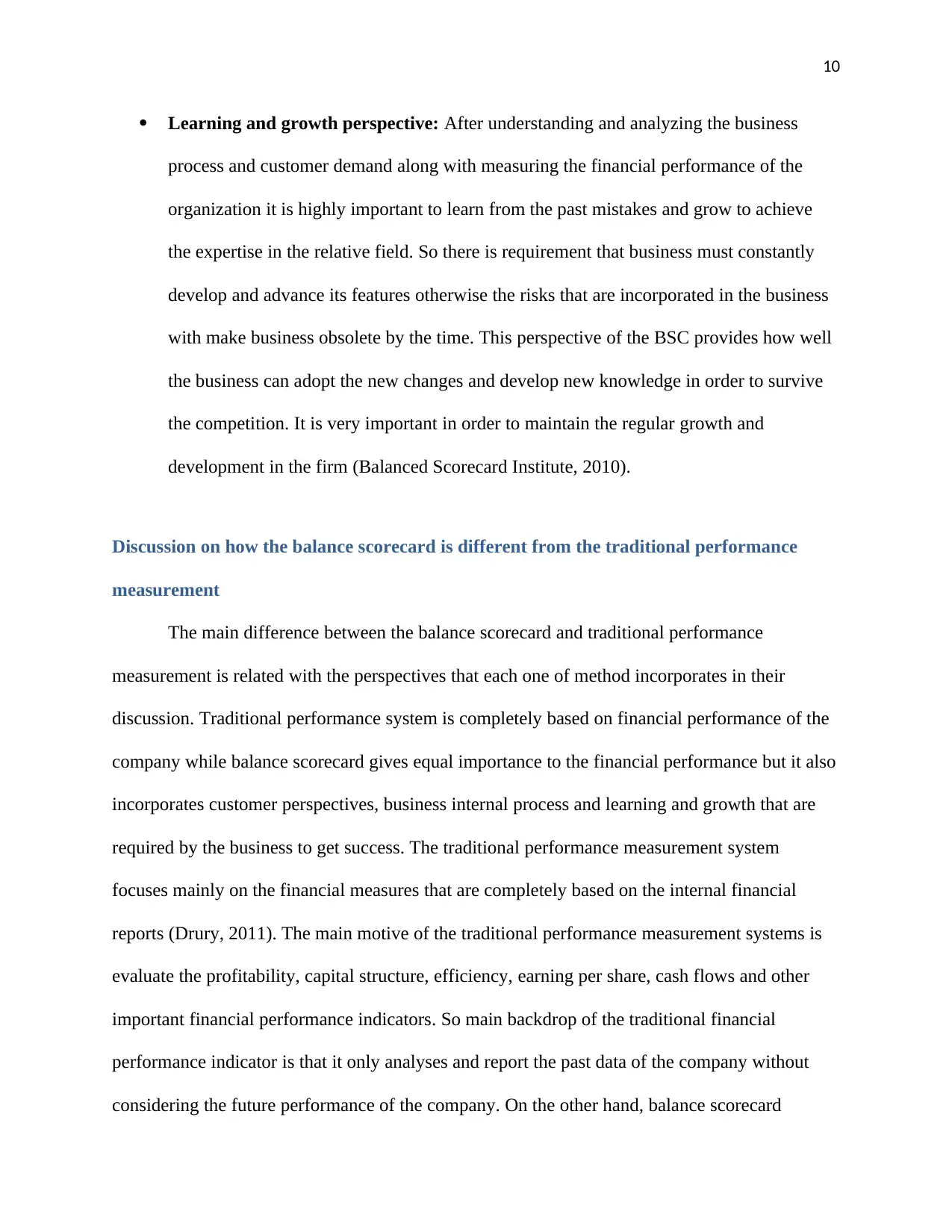
10
Learning and growth perspective: After understanding and analyzing the business
process and customer demand along with measuring the financial performance of the
organization it is highly important to learn from the past mistakes and grow to achieve
the expertise in the relative field. So there is requirement that business must constantly
develop and advance its features otherwise the risks that are incorporated in the business
with make business obsolete by the time. This perspective of the BSC provides how well
the business can adopt the new changes and develop new knowledge in order to survive
the competition. It is very important in order to maintain the regular growth and
development in the firm (Balanced Scorecard Institute, 2010).
Discussion on how the balance scorecard is different from the traditional performance
measurement
The main difference between the balance scorecard and traditional performance
measurement is related with the perspectives that each one of method incorporates in their
discussion. Traditional performance system is completely based on financial performance of the
company while balance scorecard gives equal importance to the financial performance but it also
incorporates customer perspectives, business internal process and learning and growth that are
required by the business to get success. The traditional performance measurement system
focuses mainly on the financial measures that are completely based on the internal financial
reports (Drury, 2011). The main motive of the traditional performance measurement systems is
evaluate the profitability, capital structure, efficiency, earning per share, cash flows and other
important financial performance indicators. So main backdrop of the traditional financial
performance indicator is that it only analyses and report the past data of the company without
considering the future performance of the company. On the other hand, balance scorecard
Learning and growth perspective: After understanding and analyzing the business
process and customer demand along with measuring the financial performance of the
organization it is highly important to learn from the past mistakes and grow to achieve
the expertise in the relative field. So there is requirement that business must constantly
develop and advance its features otherwise the risks that are incorporated in the business
with make business obsolete by the time. This perspective of the BSC provides how well
the business can adopt the new changes and develop new knowledge in order to survive
the competition. It is very important in order to maintain the regular growth and
development in the firm (Balanced Scorecard Institute, 2010).
Discussion on how the balance scorecard is different from the traditional performance
measurement
The main difference between the balance scorecard and traditional performance
measurement is related with the perspectives that each one of method incorporates in their
discussion. Traditional performance system is completely based on financial performance of the
company while balance scorecard gives equal importance to the financial performance but it also
incorporates customer perspectives, business internal process and learning and growth that are
required by the business to get success. The traditional performance measurement system
focuses mainly on the financial measures that are completely based on the internal financial
reports (Drury, 2011). The main motive of the traditional performance measurement systems is
evaluate the profitability, capital structure, efficiency, earning per share, cash flows and other
important financial performance indicators. So main backdrop of the traditional financial
performance indicator is that it only analyses and report the past data of the company without
considering the future performance of the company. On the other hand, balance scorecard
Secure Best Marks with AI Grader
Need help grading? Try our AI Grader for instant feedback on your assignments.
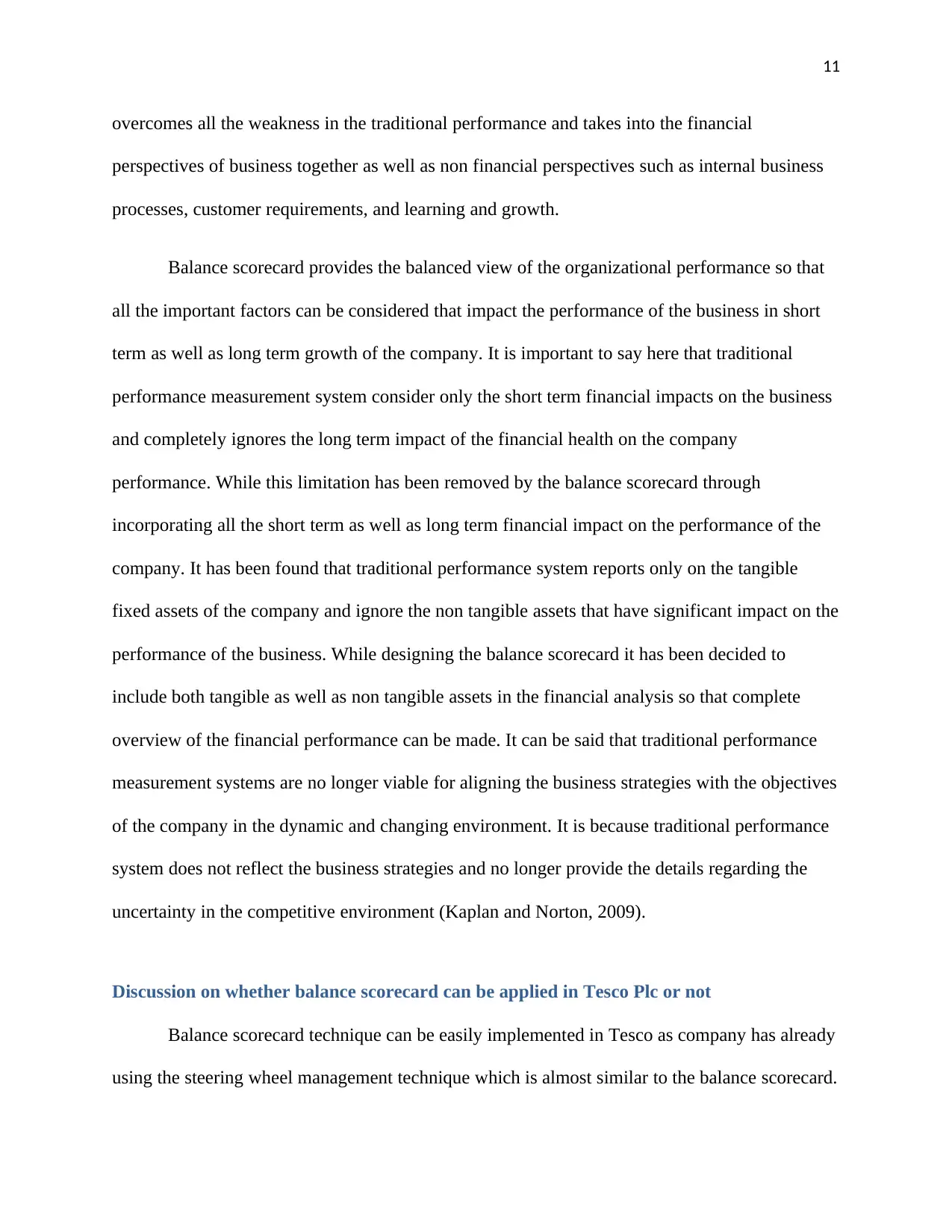
11
overcomes all the weakness in the traditional performance and takes into the financial
perspectives of business together as well as non financial perspectives such as internal business
processes, customer requirements, and learning and growth.
Balance scorecard provides the balanced view of the organizational performance so that
all the important factors can be considered that impact the performance of the business in short
term as well as long term growth of the company. It is important to say here that traditional
performance measurement system consider only the short term financial impacts on the business
and completely ignores the long term impact of the financial health on the company
performance. While this limitation has been removed by the balance scorecard through
incorporating all the short term as well as long term financial impact on the performance of the
company. It has been found that traditional performance system reports only on the tangible
fixed assets of the company and ignore the non tangible assets that have significant impact on the
performance of the business. While designing the balance scorecard it has been decided to
include both tangible as well as non tangible assets in the financial analysis so that complete
overview of the financial performance can be made. It can be said that traditional performance
measurement systems are no longer viable for aligning the business strategies with the objectives
of the company in the dynamic and changing environment. It is because traditional performance
system does not reflect the business strategies and no longer provide the details regarding the
uncertainty in the competitive environment (Kaplan and Norton, 2009).
Discussion on whether balance scorecard can be applied in Tesco Plc or not
Balance scorecard technique can be easily implemented in Tesco as company has already
using the steering wheel management technique which is almost similar to the balance scorecard.
overcomes all the weakness in the traditional performance and takes into the financial
perspectives of business together as well as non financial perspectives such as internal business
processes, customer requirements, and learning and growth.
Balance scorecard provides the balanced view of the organizational performance so that
all the important factors can be considered that impact the performance of the business in short
term as well as long term growth of the company. It is important to say here that traditional
performance measurement system consider only the short term financial impacts on the business
and completely ignores the long term impact of the financial health on the company
performance. While this limitation has been removed by the balance scorecard through
incorporating all the short term as well as long term financial impact on the performance of the
company. It has been found that traditional performance system reports only on the tangible
fixed assets of the company and ignore the non tangible assets that have significant impact on the
performance of the business. While designing the balance scorecard it has been decided to
include both tangible as well as non tangible assets in the financial analysis so that complete
overview of the financial performance can be made. It can be said that traditional performance
measurement systems are no longer viable for aligning the business strategies with the objectives
of the company in the dynamic and changing environment. It is because traditional performance
system does not reflect the business strategies and no longer provide the details regarding the
uncertainty in the competitive environment (Kaplan and Norton, 2009).
Discussion on whether balance scorecard can be applied in Tesco Plc or not
Balance scorecard technique can be easily implemented in Tesco as company has already
using the steering wheel management technique which is almost similar to the balance scorecard.
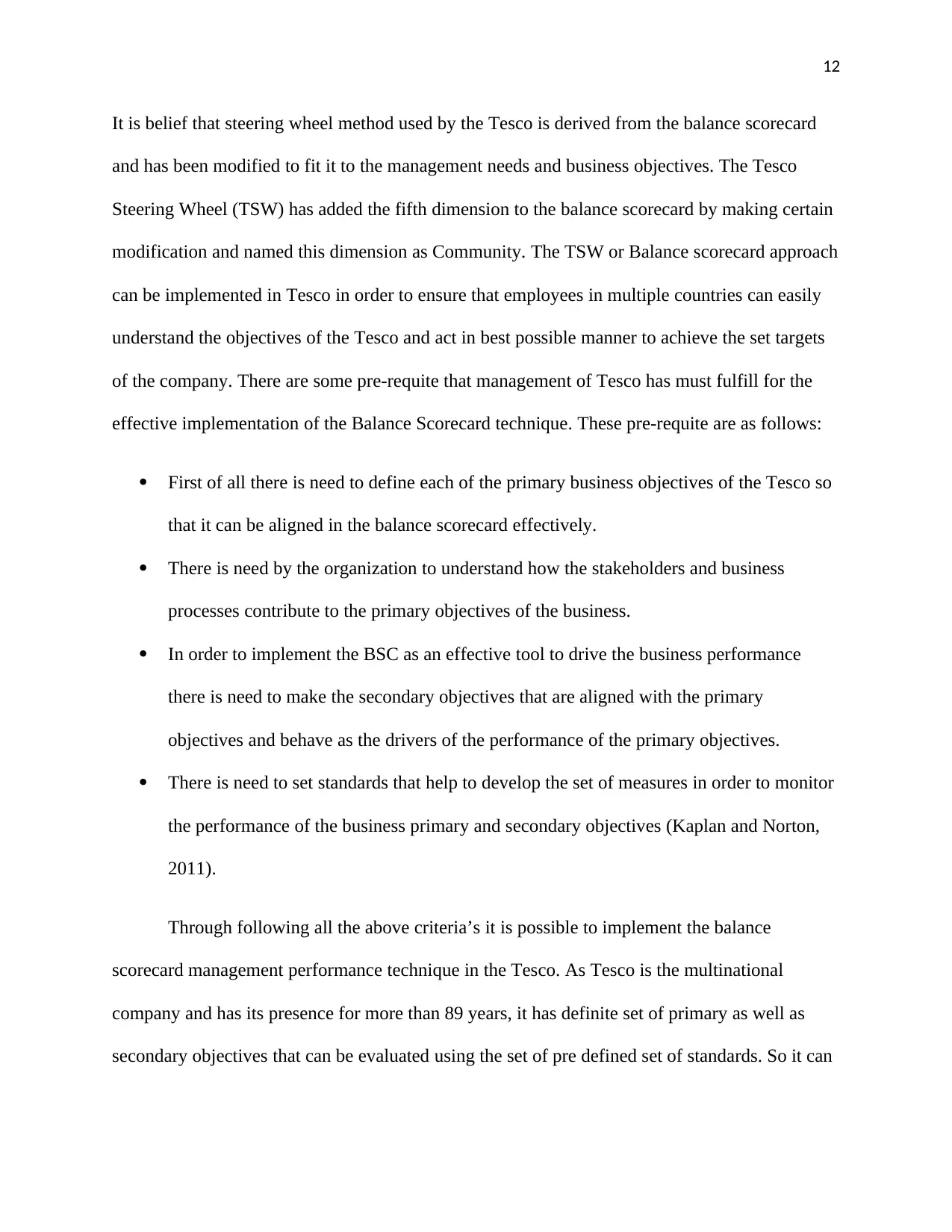
12
It is belief that steering wheel method used by the Tesco is derived from the balance scorecard
and has been modified to fit it to the management needs and business objectives. The Tesco
Steering Wheel (TSW) has added the fifth dimension to the balance scorecard by making certain
modification and named this dimension as Community. The TSW or Balance scorecard approach
can be implemented in Tesco in order to ensure that employees in multiple countries can easily
understand the objectives of the Tesco and act in best possible manner to achieve the set targets
of the company. There are some pre-requite that management of Tesco has must fulfill for the
effective implementation of the Balance Scorecard technique. These pre-requite are as follows:
First of all there is need to define each of the primary business objectives of the Tesco so
that it can be aligned in the balance scorecard effectively.
There is need by the organization to understand how the stakeholders and business
processes contribute to the primary objectives of the business.
In order to implement the BSC as an effective tool to drive the business performance
there is need to make the secondary objectives that are aligned with the primary
objectives and behave as the drivers of the performance of the primary objectives.
There is need to set standards that help to develop the set of measures in order to monitor
the performance of the business primary and secondary objectives (Kaplan and Norton,
2011).
Through following all the above criteria’s it is possible to implement the balance
scorecard management performance technique in the Tesco. As Tesco is the multinational
company and has its presence for more than 89 years, it has definite set of primary as well as
secondary objectives that can be evaluated using the set of pre defined set of standards. So it can
It is belief that steering wheel method used by the Tesco is derived from the balance scorecard
and has been modified to fit it to the management needs and business objectives. The Tesco
Steering Wheel (TSW) has added the fifth dimension to the balance scorecard by making certain
modification and named this dimension as Community. The TSW or Balance scorecard approach
can be implemented in Tesco in order to ensure that employees in multiple countries can easily
understand the objectives of the Tesco and act in best possible manner to achieve the set targets
of the company. There are some pre-requite that management of Tesco has must fulfill for the
effective implementation of the Balance Scorecard technique. These pre-requite are as follows:
First of all there is need to define each of the primary business objectives of the Tesco so
that it can be aligned in the balance scorecard effectively.
There is need by the organization to understand how the stakeholders and business
processes contribute to the primary objectives of the business.
In order to implement the BSC as an effective tool to drive the business performance
there is need to make the secondary objectives that are aligned with the primary
objectives and behave as the drivers of the performance of the primary objectives.
There is need to set standards that help to develop the set of measures in order to monitor
the performance of the business primary and secondary objectives (Kaplan and Norton,
2011).
Through following all the above criteria’s it is possible to implement the balance
scorecard management performance technique in the Tesco. As Tesco is the multinational
company and has its presence for more than 89 years, it has definite set of primary as well as
secondary objectives that can be evaluated using the set of pre defined set of standards. So it can
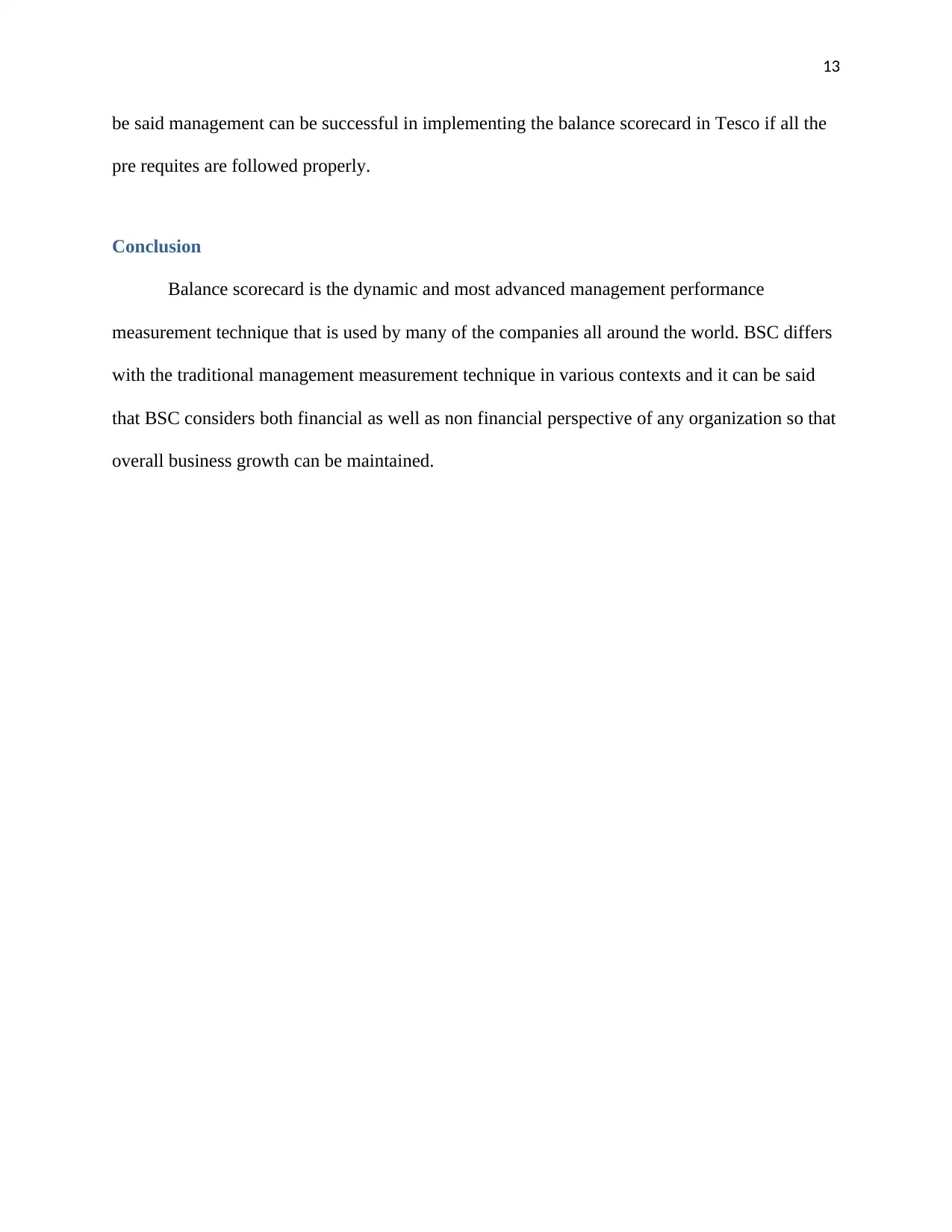
13
be said management can be successful in implementing the balance scorecard in Tesco if all the
pre requites are followed properly.
Conclusion
Balance scorecard is the dynamic and most advanced management performance
measurement technique that is used by many of the companies all around the world. BSC differs
with the traditional management measurement technique in various contexts and it can be said
that BSC considers both financial as well as non financial perspective of any organization so that
overall business growth can be maintained.
be said management can be successful in implementing the balance scorecard in Tesco if all the
pre requites are followed properly.
Conclusion
Balance scorecard is the dynamic and most advanced management performance
measurement technique that is used by many of the companies all around the world. BSC differs
with the traditional management measurement technique in various contexts and it can be said
that BSC considers both financial as well as non financial perspective of any organization so that
overall business growth can be maintained.
Paraphrase This Document
Need a fresh take? Get an instant paraphrase of this document with our AI Paraphraser
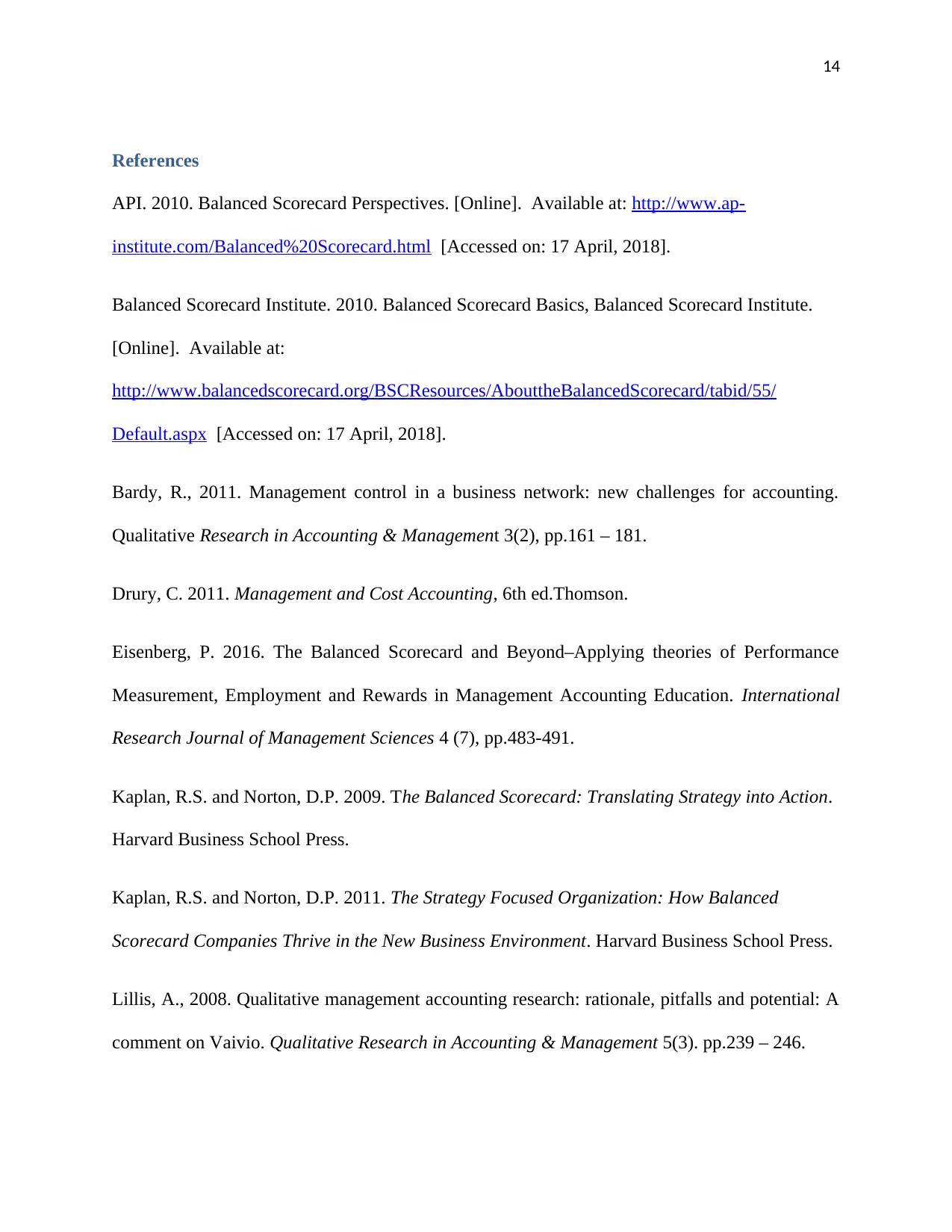
14
References
API. 2010. Balanced Scorecard Perspectives. [Online]. Available at: http://www.ap-
institute.com/Balanced%20Scorecard.html [Accessed on: 17 April, 2018].
Balanced Scorecard Institute. 2010. Balanced Scorecard Basics, Balanced Scorecard Institute.
[Online]. Available at:
http://www.balancedscorecard.org/BSCResources/AbouttheBalancedScorecard/tabid/55/
Default.aspx [Accessed on: 17 April, 2018].
Bardy, R., 2011. Management control in a business network: new challenges for accounting.
Qualitative Research in Accounting & Management 3(2), pp.161 – 181.
Drury, C. 2011. Management and Cost Accounting, 6th ed.Thomson.
Eisenberg, P. 2016. The Balanced Scorecard and Beyond–Applying theories of Performance
Measurement, Employment and Rewards in Management Accounting Education. International
Research Journal of Management Sciences 4 (7), pp.483-491.
Kaplan, R.S. and Norton, D.P. 2009. The Balanced Scorecard: Translating Strategy into Action.
Harvard Business School Press.
Kaplan, R.S. and Norton, D.P. 2011. The Strategy Focused Organization: How Balanced
Scorecard Companies Thrive in the New Business Environment. Harvard Business School Press.
Lillis, A., 2008. Qualitative management accounting research: rationale, pitfalls and potential: A
comment on Vaivio. Qualitative Research in Accounting & Management 5(3). pp.239 – 246.
References
API. 2010. Balanced Scorecard Perspectives. [Online]. Available at: http://www.ap-
institute.com/Balanced%20Scorecard.html [Accessed on: 17 April, 2018].
Balanced Scorecard Institute. 2010. Balanced Scorecard Basics, Balanced Scorecard Institute.
[Online]. Available at:
http://www.balancedscorecard.org/BSCResources/AbouttheBalancedScorecard/tabid/55/
Default.aspx [Accessed on: 17 April, 2018].
Bardy, R., 2011. Management control in a business network: new challenges for accounting.
Qualitative Research in Accounting & Management 3(2), pp.161 – 181.
Drury, C. 2011. Management and Cost Accounting, 6th ed.Thomson.
Eisenberg, P. 2016. The Balanced Scorecard and Beyond–Applying theories of Performance
Measurement, Employment and Rewards in Management Accounting Education. International
Research Journal of Management Sciences 4 (7), pp.483-491.
Kaplan, R.S. and Norton, D.P. 2009. The Balanced Scorecard: Translating Strategy into Action.
Harvard Business School Press.
Kaplan, R.S. and Norton, D.P. 2011. The Strategy Focused Organization: How Balanced
Scorecard Companies Thrive in the New Business Environment. Harvard Business School Press.
Lillis, A., 2008. Qualitative management accounting research: rationale, pitfalls and potential: A
comment on Vaivio. Qualitative Research in Accounting & Management 5(3). pp.239 – 246.
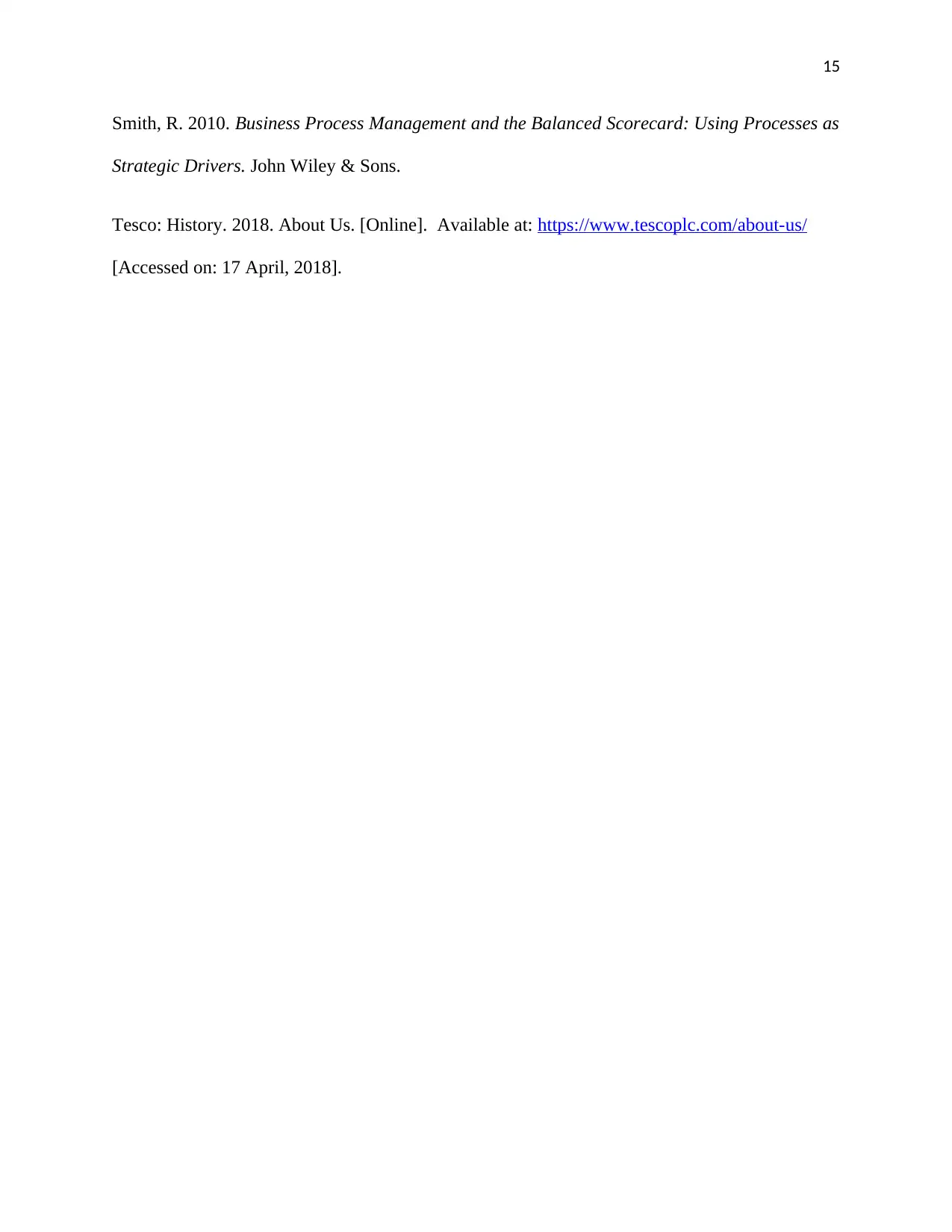
15
Smith, R. 2010. Business Process Management and the Balanced Scorecard: Using Processes as
Strategic Drivers. John Wiley & Sons.
Tesco: History. 2018. About Us. [Online]. Available at: https://www.tescoplc.com/about-us/
[Accessed on: 17 April, 2018].
Smith, R. 2010. Business Process Management and the Balanced Scorecard: Using Processes as
Strategic Drivers. John Wiley & Sons.
Tesco: History. 2018. About Us. [Online]. Available at: https://www.tescoplc.com/about-us/
[Accessed on: 17 April, 2018].
1 out of 15
Related Documents
Your All-in-One AI-Powered Toolkit for Academic Success.
+13062052269
info@desklib.com
Available 24*7 on WhatsApp / Email
![[object Object]](/_next/static/media/star-bottom.7253800d.svg)
Unlock your academic potential
© 2024 | Zucol Services PVT LTD | All rights reserved.





